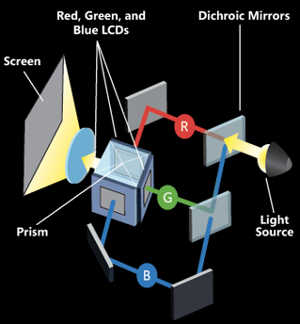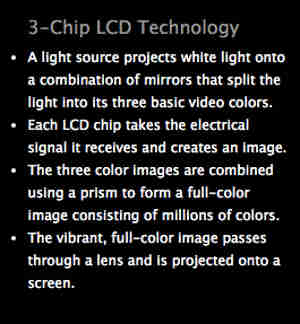What is meaning of LCD projector
'LCD' is the short form for 'Liquid Crystal Display' and is the same technology that you find inside an LED/LCD TV. The LCD panel is made up of millions of tiny Liquid Crystals, one each for every pixel in a Digital picture: that means for the High Definition HD format there will be 1920x1080 which equals to just over 2 million Liquid crystals in each tiny LCD Chip which goes into a projector.
Each Liquid crystal can independently turn 'on' or 'off' with an electric voltage applied to it. When in the Opaque state it blocks the passage of light through it and when in the transparent state, will allow light to pass through.
Thus the LCD chip acts like the film rolls used in projectors of the old Cinema houses. Those film rolls had translucent coloured images imprinted on the film and a bright light beam passed through the film to project the colored film picture on to the cinema screen. In a digital picture the color picture signals are in RGB: Red, Green and Blue color information. In 3LCD projector, 3 separate RGB: Red, Green and Blue light beam is passed through 3 separate LCD chips and then the outgoing beams of RGB light are combined by prisms back into a multicolored beam and projected on to the screen.
3LCD projector meaning, How EPSON 3LCD projector works
The meaning of a 3 LCD projector is that it is a projector having 3 LCDs, each of which gives a picture using either Red, Green or Blue light component of white light and these 3 images are combined to give one final image which is projected on to the screen. The diagram below explains how the 3 LCD projectors from the world leader 'EPSON' works.


LCD projectors are mostly 3 chip projectors and mostly based on the '3LCD' brand configuration as shown in the image above. 3LCD is a technology was pioneered in the 1980s by the Japanese Company 'Seiko Epson', famous for their Watches and also the makers of Epson Projectors and Printers. The 3LCD technology is now marketed by an Epson affiliated Company known by the same name: '3LCD'. Epson has licensed the 3LCD technology out to many other projector manufacturers.
How the EPSON 3 LCD projector works is explained in the picture above. A bright white light source is split into individual beams of RGB light, using 3 Dichroic mirrors. Dichroic mirrors are mirrors which reflects certain wave length light and let others pass through. In the case of the 3LCD projector, the first Dichroic mirror reflects Red light but allows Green and Blue light to pass through. The second Dichroic mirror reflects Green but lets Blue light through and the final mirror reflects the remaining Blue light.
LCD projector advantages and disadvantages, LCD DLP projector difference
The cheaper LCD projectors use Metal Halide UHP projector lamps and these lamps are very bright, but have problems like getting hot and the need to replace the projector lamps every two years or so. ...For more, see our page on Projector lamps.
The main LCD DLP projector difference is that in LCD projectors the light passes through the LCD picture element wheras in a DLP projector the light is reflected of the DLP chip which has millions of tiny mirrors.
LCD projectors produce much brighter pictures than single chip DLP projectors of the same Lumen output. The disadvantages of LCD projectors compared with DLP projectors are lower contrast ratio and the tendency to have a ‘Screen Door’ effect: seeing individual pixels as if looking through a net or the mesh of a screen door. But these were problems that used to be there in the older generation LCD projectors and in modern LCD projectors you will hardly ever face such problems.
Screen Door Effect in LCD Projectors
As mentioned above, ‘Screen Door’ effect is seeing a net like pattern on the screen on a projected LCD picture. This is actually the pattern of individual pixels and it feels as if looking through a net or the mesh of a screen door. This problem is only noticable when you go close-up to the screen.
What causes ‘Screen Door’ effect is that in LCD Chips, there are minute gaps between pixels to allow space for control circuitry to the transistors of each pixel. When light signals pass through the LCD Chip, the minute gaps between pixels show up in the magnified screen image, in the form of the net like Screen Door Effect.
Modern LCD projectors have devised several ingenious methods to hide the SCreen Door Effect in LCD projector pictures, and it is hardly noticeable in good LCD projectors.
LCD projectors, even with these slight disadvantages are a very good buy, great value for the money. Personally I prefer a 3 LCD projector over a single chip DLP projector, because 3 LCD projectors are brighter, have very good picture quality, even at high HD resolutions and do not suffer from problems like the 'Rainbow Effect' in single chip DLP projectors.
Where to buy Home Theater Projectors and Projector Screens online
The best place to buy Projectors and Projector screens is the Amazon online store in your country. Amazon is best to buy online Projectors and Screens because not only are they very competitively priced, but you also have the assurance of service, and in the worst case, even return for a refund in case you are not satisfied.
Links for Home Theater Projectors
This is the Link for Home Theater Projectors from Amazon AUSTRALIA
This is the Link for Home Theater Projectors from Amazon CANADA
This is the Link for Home Theater Projectors from Amazon INDIA
This is the Link for Home Theater Projectors from Amazon UK
This is the Link for Home Theater Projectors from Amazon USA
Links for Projector Screens
This is the Link for Projector Screens from Amazon AUSTRALIA
This is the Link for Projector Screens from Amazon CANADA
This is the Link for Projector Screens from Amazon India
This is the Link for Projector Screens from Amazon UK
This is the Link for Projector Screens from Amazon USA
As an Amazon Associate I earn from qualifying purchases.

All pages in our website www.whyProjector.com
Below are links to all the pages on this website and we hope you will make full use of all the great information about projectors.